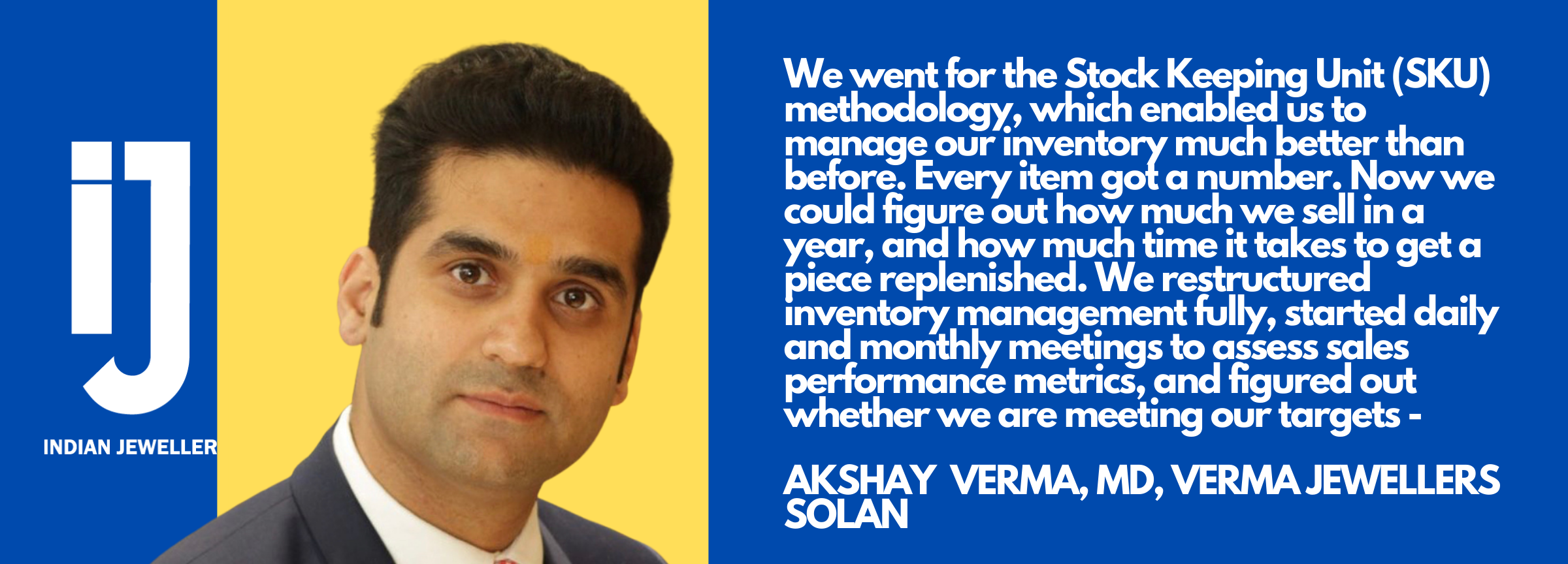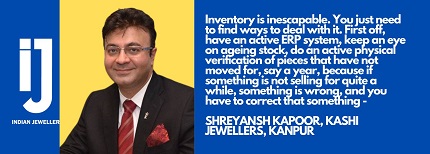Dealing with inventory pile-up is every retailer’s nightmare, but it is even more daunting for retail jewellers in view of the big-ticket items they deal in. Suneeta Kaul talks to a cross-section of the jewellery industry to find out how jewellers are pushing out slow-moving stock

What do you do when some stock does not move, or something that was hot yesterday suddenly becomes deadweight today? Retailers have different opinions on how to push out jewellery that has been static for a while, but there is unanimity on one thing – you cannot afford to understock just because you fear inventory may pile up.

Ways to deal with slow-moving stock
When you are faced with merchandise that has a below-average sales rate, it is time to act. The question is: how?
Says Shreyansh Kapoor, Vice-President, Kashi Jewellers, Kanpur, UP, “Inventory is inescapable. You just need to find ways to deal with it. First off, have an active ERP system, keep an eye on ageing stock, do an active physical verification of pieces that have not moved for, say a year, because if something is not selling for quite a while, something is wrong, and you have to correct that something.” Most jewellers tend to over-stock; such is the reality of the jewellery business. Adds Kapoor, “Customers don’t want to see 50 pieces, they want to see 500. So, we have to keep a lot of inventory.”
Family-owned jewellery businesses tend to face a bigger problem of inventory, and a very large percentage of the business in India is still family-owned.
“Most jewellery retailers have been in the business for generations,” says Akshay Verma, Managing Director, Verma Jewellers, Solan HP, adding, “They don’t really have a mechanism for dealing with their inventory. We didn’t either. But during the lockdown, we came to the realization that we need to create a scientific system that will enable us to figure out what to stock and how much of it to stock. We went for the Stock Keeping Unit (SKU) methodology, which enabled us to manage our inventory much better than before. Every item got a number. Now we could figure out how much we sell in a year, and how much time it takes to get a piece replenished. We restructured inventory management fully, started daily and monthly meetings to assess sales performance metrics, and figured out whether we are meeting our targets. It has worked out very well for us.”

Categorising the merchandise can go a long way in dealing with inventory, and preventing stock from lying unsold. Says Vaibhav Saraf, Director, Aisshpra Gems & Jewels, Gorakhpur, UP, “Proper categorisation of jewellery plays a vital role in identifying fast- or slow-moving inventory. Exclusivity of jewellery is also a major factor when deciding if the jewellery is fast- or slow-moving.”
Sometimes, stock starts to get stagnant simply because market trends, customer demands and preferences change. Or it could be that enough thought was not put into positioning the product properly.
“Customer demand has a great part in determining the inventory flow. But at times, poor marketing skills can also be a reason for your slow-moving merchandise,” opines Jay Mehta, Director, Pooja Diamonds, Ahmedabad. “Great marketing skills can sell even slow-moving stock. You need to position the products in a different and unique manner, while using attractive ideas to promote them,” he adds.
Dealing with inventory requires a combination of scientific methodology and imagination. Says Kailash Kabra, Founder and Managing Director, K K Jewels. Ahmedabad, “The best way to deal with slow-moving stock is to modify it, maybe by changing the colour of the gold, or adding some pieces to it to change its look.”

Retail jewellers agree that modifying the jewellery is one of the first options to deal with unsold stock. According to Ishu Datwani, Founder, Anmol Jewellers, Mumbai, “Going for cosmetic surgery of jewellery that does not move as per plan is a good method of dealing with the problem. We go for re-polishing, adding stones or pearls and give it a new, and make it more appealing look.If both these steps don’t work, then we just melt the piece.”

Announce a sale? Or not?
While jewellers are broadly in agreement on how to deal with inventory, they have different opinions on whether announcing a sale or reducing the price is an option to deal with deadweight. Says Datwani, “You can reduce the selling price to make unsold jewellery more attractive to buyers, but rather than going on flash sales, it makes more sense to have a yearly sale where these pieces can be sold at a discounted price.”
Some industry players feel unsold stock can be put up online in an imaginative manner. “Digital marketing has a good reach and marketing your products online won’t be a bad idea. Among the thousands of consumers, it is surely possible for your slow-moving merchandise to find the right customer. Besides, organizing a flash sale is an effective way to attract more customers to enter your store. You can then make use of the opportunity by bundling the slow-moving stock with the fast-moving one. You can also offer from 30% to 40% discount on slow-moving inventory,” says Mehta.

But not all agree. According to Saraf, “Discounts and flash sales to push slow-moving inventory is never a good idea. It puts a notion into the client’s mind that the jeweller has a huge margin on jewellery and that the discount is being passed on selective pieces due to some issue with the jewellery.”

Agrees Kabra, “We believe in the Louis Vuitton strategy -- if anything doesn’t sell scrap it, but don’t sell it cheap as it will spoil the brand name and then the client will always wait for your sale and the rest of the months you will be sitting idle.”
Inventory is always going to be a tricky issue -- jewellers cannot afford to understock, but they will face problems if they overstock. In the end, each company has to find its own way of dealing with the problem.
Be the first to comment